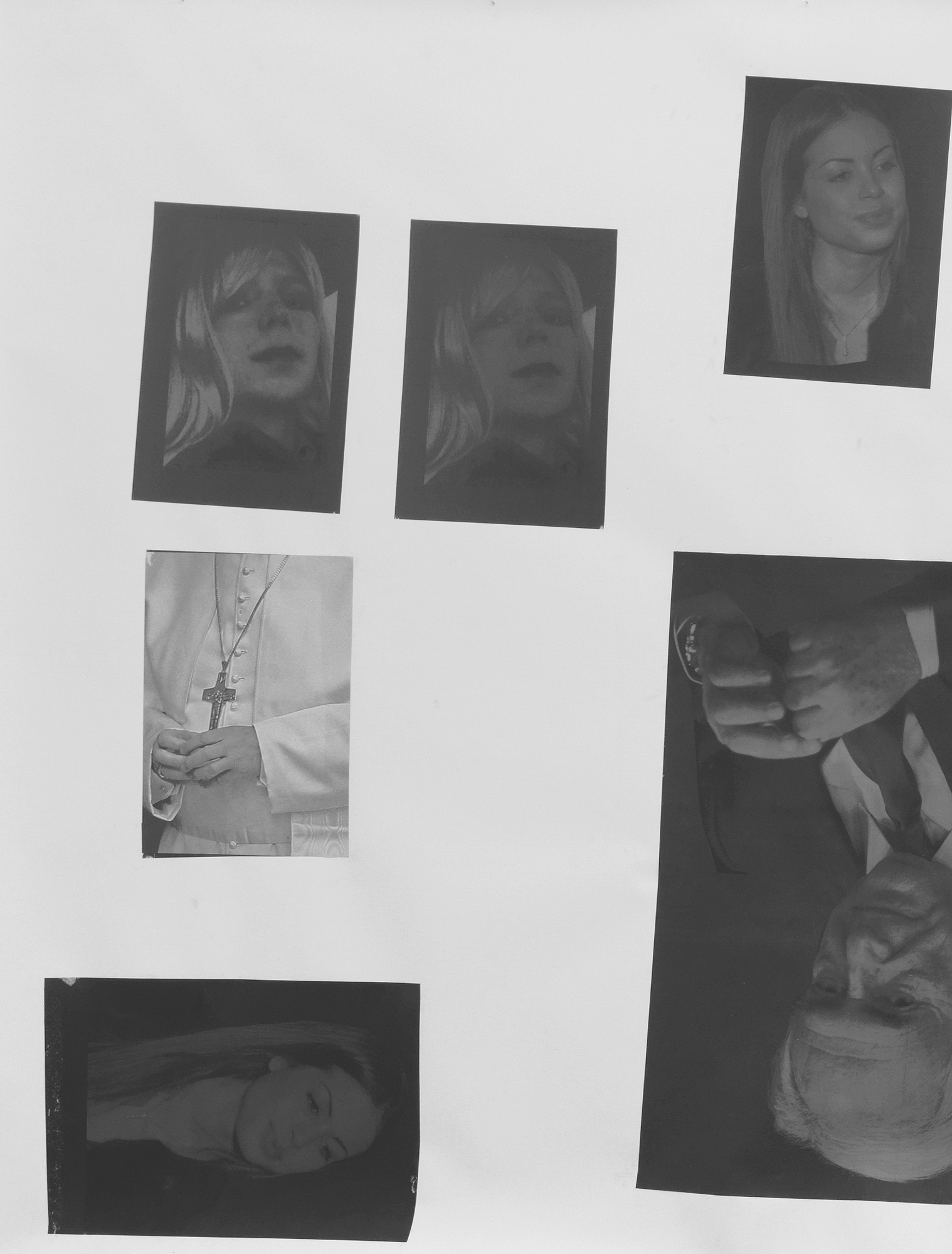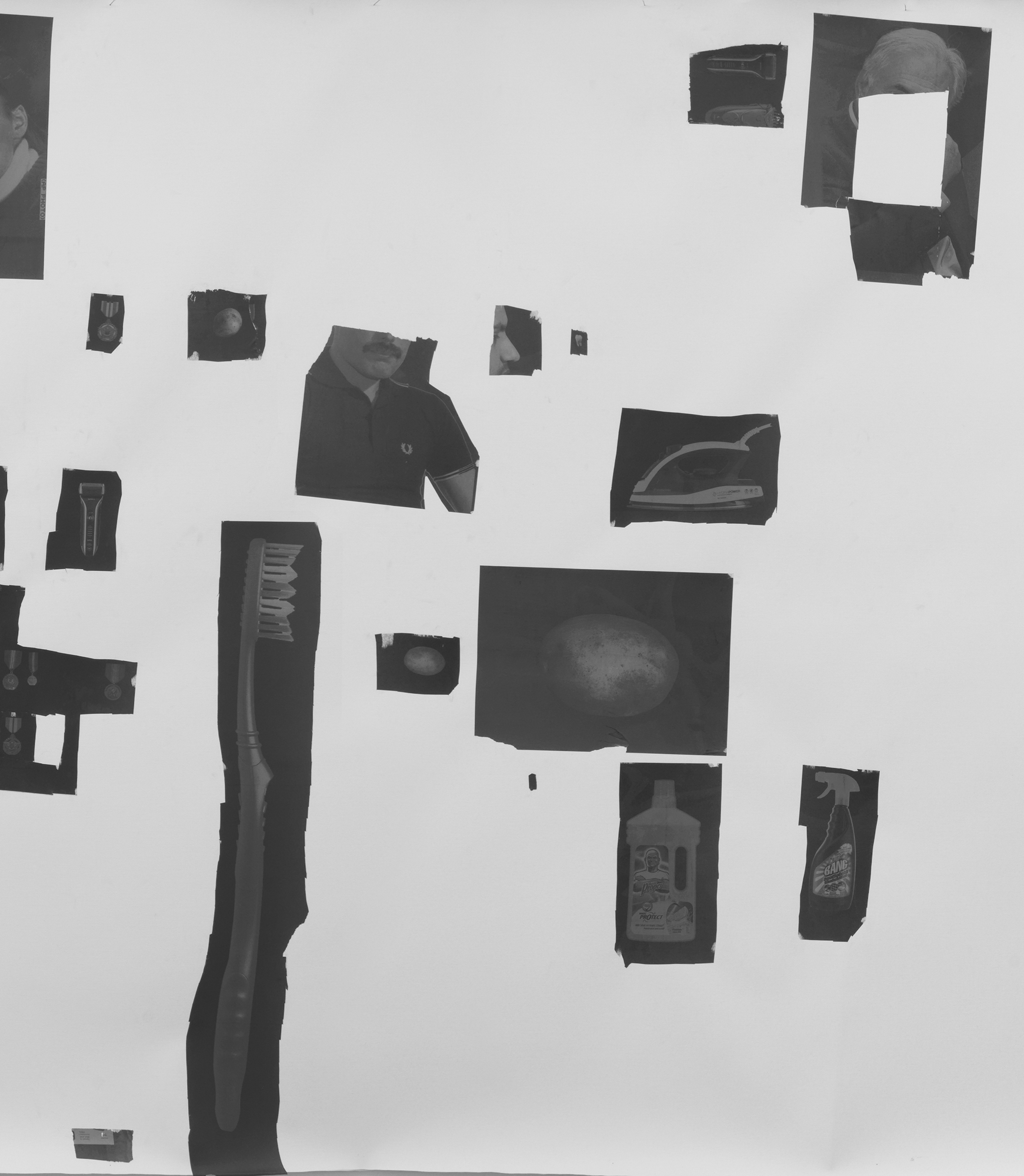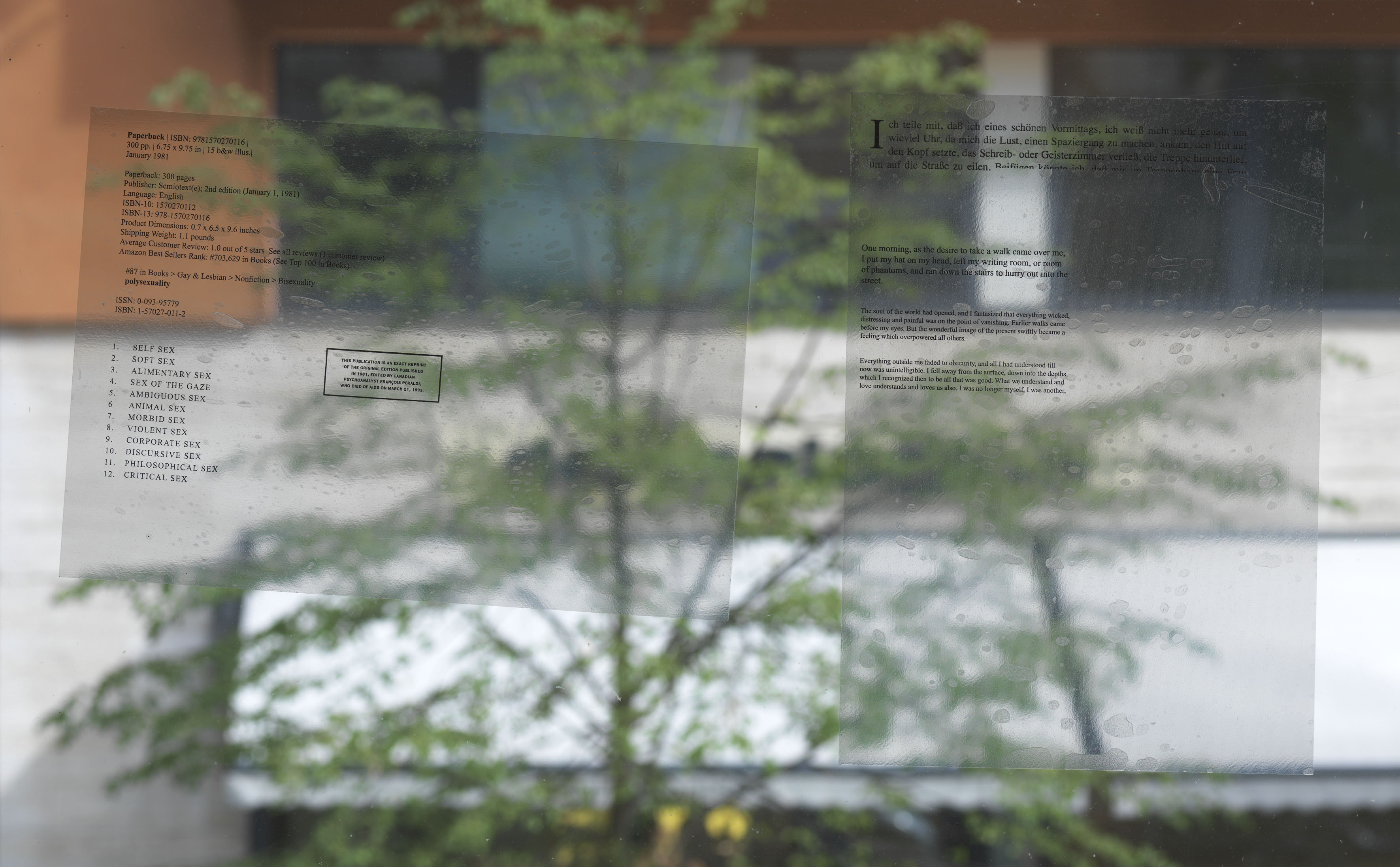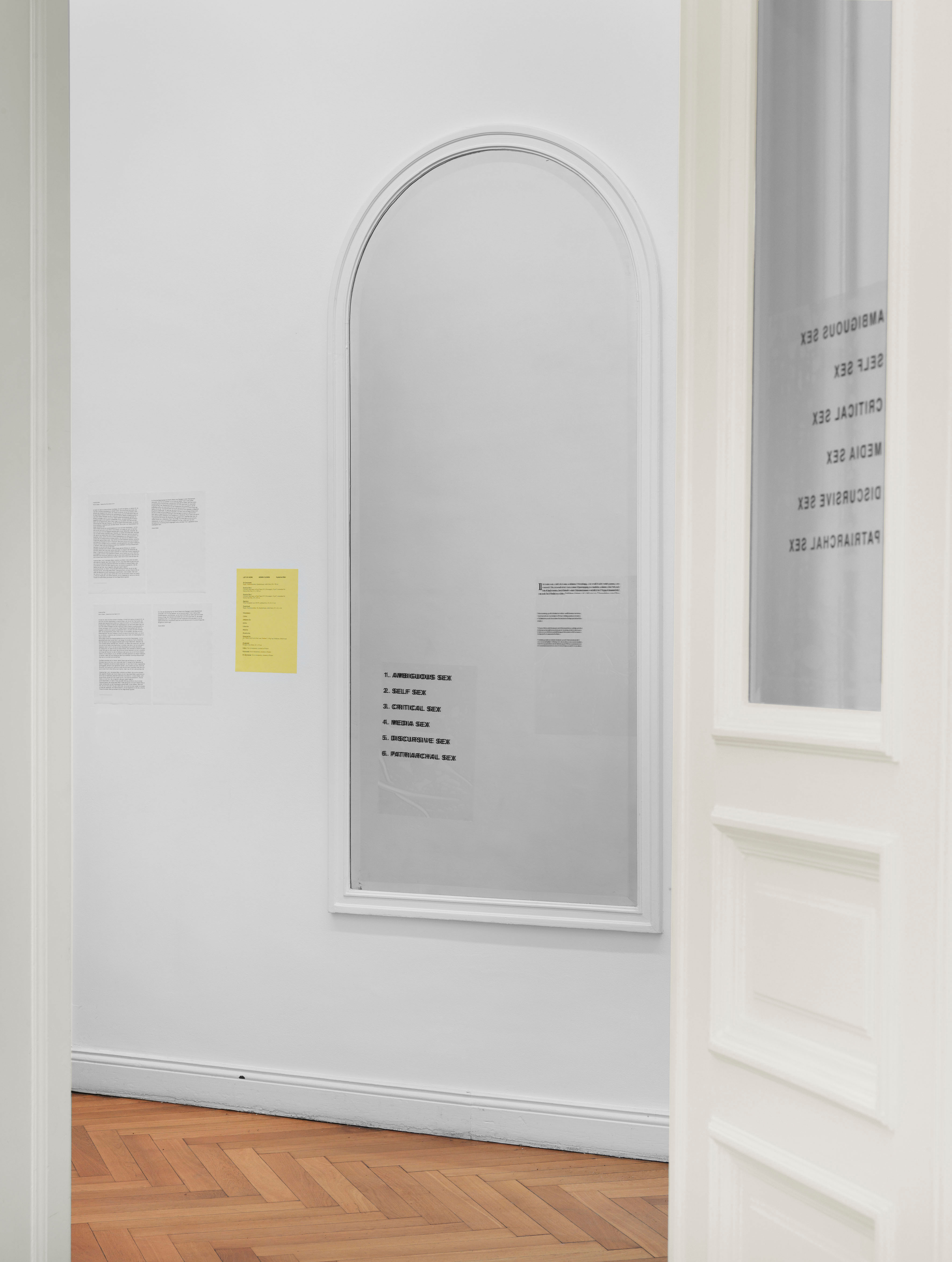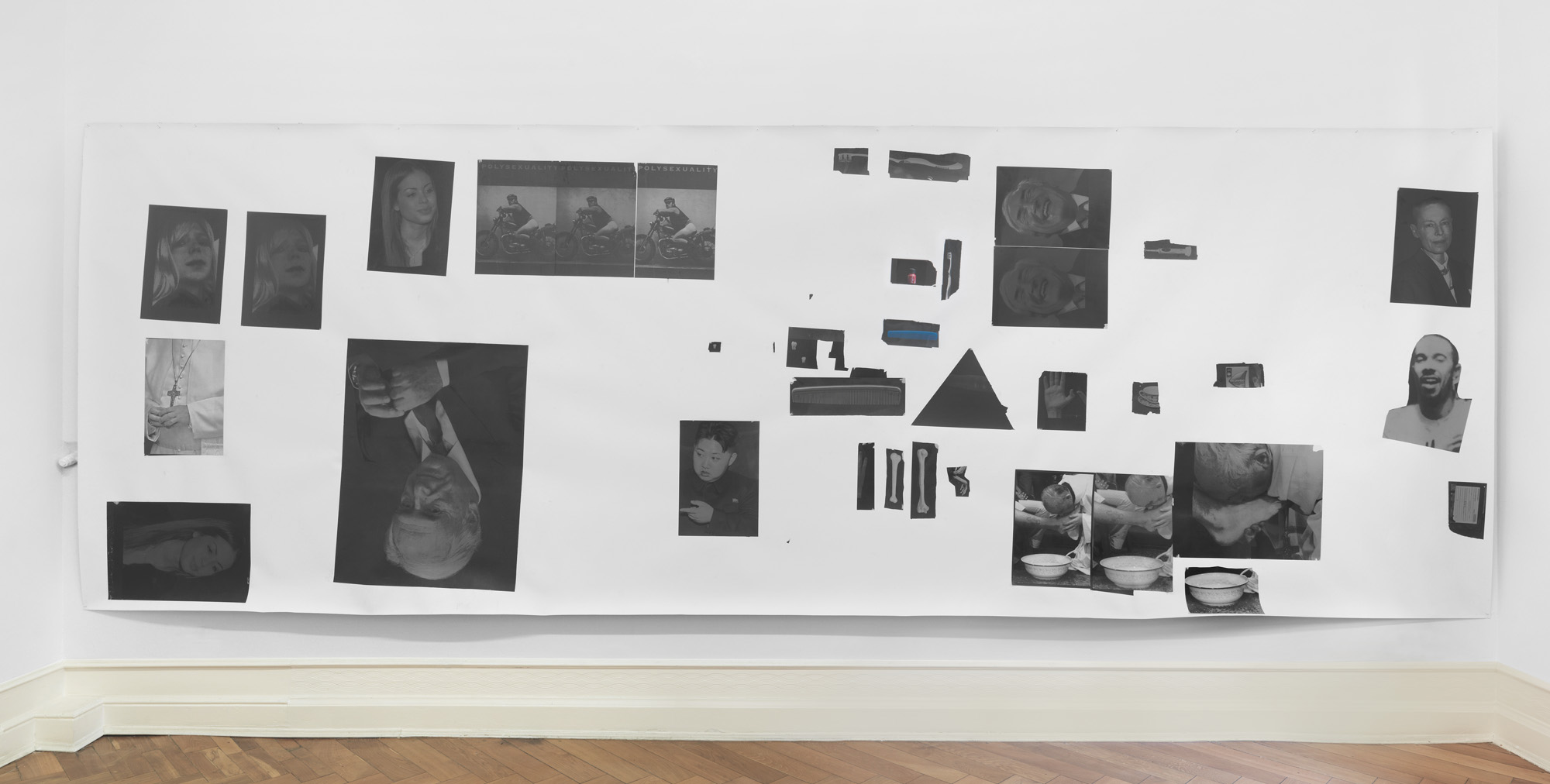Henrik Olesen: What is Most Deep is the Skin
Henrik Olesen, Hysterical Men 2, 2013, canvas, Inkjet print on newspaper, gouache, glue, 204 x 585 cm [photo: courtesy of Artist and Galerie Buchholz, Berlin/Cologne/New York]
Share:
After “a few” attempts to hang himself, writer Robert Walser committed himself to the Waldau mental asylum near Bern, Switzerland, in 1929.1 He was later involuntarily confined and moved to an institution in Herisau, a village in the Swiss Alps. He was diagnosed with schizophrenia and a form of catatonia.2 At Herisau he spent his days aiding the nurses in cleaning the wards each morning and gluing paper bags together or sorting beans, lentils, and chestnuts each afternoon.3 During his institutionalization Walser entirely ceased his literary productions. He was found dead on Christmas day, 1956, lying in the snow, on the asylum’s grounds. He had been on a walk.
Walser figures prominently in artist Henrik Olesen’s exhibitions Hysterical Men at Galerie Buchholz, Berlin, in 2013 and, four years later, The Walk at CCA Wattis Institute for Contemporary Arts, San Francisco. Germinal to Olesen‘s collective works are several others who manifested symptoms of neurodivergence in the form of what has been named mental illness. Consider three: between 1937 and 1946, writer, artist, actor, and theater director Antonin Artaud was confined, schizophrenic and floridly psychotic, to five separate insane asylums in France.4 Philosopher Gilles Deleuze, his health intensely deteriorated from a respiratory ailment, jumped out of his Paris apartment window in 1995, whereas his co-author, psychoanalyst Félix Guattari, oscillated lifelong between periods of frantic mania and immobilizing depression until his death a few years before Deleuze’s.5
A fourth is mathematician Alan Turing, who in 1936 proposed a theoretical machine that remains the basis of modern computing and whose housekeeper found him dead from cyanide poisoning in 1954. Two years before his death, Turing had been court-ordered to undergo chemical castration as the alternative to incarceration for being caught out as a homosexual in postwar England. Olesen developed a project involving Turing in 2008, at which time the mathematician’s major biographer had long concluded his death was suicide by ingesting an apple laced with poison.6 Note that the year Turing began his synthetic estrogen treatments the American Psychiatric Association published that homosexuality qualified as a “sociopathic personality disturbance,” codifying the pathologization of queerness.7 Even if the depression Turing experienced during his organotherapy did not signal self-inflicted death, Turing’s homosexuality became part of the medical examiner’s verdict, who was convinced Turing committed suicide, speaking of the “mental processes” of “a man of [Turing’s] type.”8
Henrik Olesen, Hysterical Men 1, 2013, canvas, Inkjet print on newspaper, gouache, glue, 215 x 1000 cm [photo: courtesy of Artist and Galerie Buchholz, Berlin/Cologne/New York]
A diagnosis of neurodivergence is not in itself a disability, or an inability, incapacity, or lack of ability to perform a function. Focusing here on diagnoses of mental illness, its symptoms are what can manifest disability—through how one’s brain works and body behaves, what one sees and hears, how one thinks and acts, and to the incapacity to hold “gainful” employment, to care for oneself and others, and that can thus cause the end of one’s life.
At the same time, mental illness is an invisible disease. It cannot be visually confirmed the way certain physical disabilities can, such as a crippled limb. The equal of visualizing, for example, schizophrenia requires neuroimaging technology, primarily the kind that uses radio waves and magnetic fields, connected to a video-display screen that shows the reduced gray brain matter now widely thought endemic to the disease. Such invisibility has meant, as Michel Foucault spent much of his life articulating, a history of madness that has been produced at the same time as its medical diagnoses. It has led to charges of faked behaviors by the mentally ill. One of Walser’s most prolific translators refuses to believe he was sick, writing that his hallucinations were merely him “pretending.”9 Part of Olesen’s 2008 work consists of collaged photo portraits of Turing paired with excerpts from letters and papers by the mathematician and quotations adapted from Artaud, Deleuze, and Guattari but with images of their persons omitted. Hysterical Men and The Walk similarly include passages by, but no images of, Walser. He joins the others in being pictorially as invisible as their sicknesses.
Henrik Olesen, Hysterical Men 2, 2013, canvas, Inkjet print on newspaper, gouache, glue, 204 x 585 cm [photo: courtesy of Artist and Galerie Buchholz, Berlin/Cologne/New York]
Olesen reprinted Artaud’s 1947 radio play To Have Done With the Judgment of God in two of his catalogues, from 2010 and 2011.10 The play denounces American militarism; is anti-Catholic; celebrates the Tarahumara (Rarámuri) and horses; and is full of references to sperm, fecality, farts, and bodies.
Near the end Artaud’s play reads:
Man is sick because he is badly
constructed.
We must make up our minds to strip
him bare in order to scrape off that
animalcule that itches him mortally,
god,
and with god
his organs.
For you can tie me up if you wish,
but there is nothing more useless than
an organ.
When you have made him a body
without organs,
then you will have delivered him
from all his automatic reactions
and restored him to his true freedom.11
Deleuze and Guattari revisited Artaud’s “body without organs” (aka BwO) throughout the 1970s and 80s, notably in the two-volume Capitalism and Schizophrenia, published as Anti-Oedipus (1972) and A Thousand Plateaus (1980). The chapter “The Body without Organs” in Anti-Oedipus claims there is a “repulsion of desiring-machines”—that which takes desire as a relentless flow and seeks to control and conduct it—“by the body without organs.”12 The chapter “November 28, 1947: How Do You Make Yourself a Body Without Organs?” in A Thousand Plateaus considers BwO “a set of practices.”13
Olesen’s text pieces often quote Deleuze and Guattari, although Deleuze initially interpreted BwO in his The Logic of Sense (1969). It is this book’s definition of BwO, and its text more broadly, that most help us understand Olesen’s connection to Deleuze. One can better understand core aspects of Olesen’s work through Deleuze’s writing and the philosopher’s writing through the artist’s work.
Deleuze first described BwO “a new dimension of the schizophrenic body, an organism without parts which operates entirely by insufflation, respiration, evaporation, and fluid transmission (the superior body or body without organs of Antonin Artaud).”14 BwO exists in “the depths,” which constitutes “the absolute origin from which everything proceeds.”15 It cannot exist outside “the action-passion ambivalence,” two poles that cannot be separated: “fragmented organs—body without organs.”16 “Encasings and bruisings … represent the passive [passion] pole” while the fluid “represents the active [action] pole and the state of perfect mixture.”17 BwO remains however in the depths while “the passion of a fragmented organism” appears at the “surface,” where “we can always find schizoid fragments.”18
Henrik Olesen, Hysterical Men 1, 2013, canvas, Inkjet print on newspaper, gouache, glue, 215 x 1000 cm [photo: courtesy of Artist and Galerie Buchholz, Berlin/Cologne/New York]
Now turn to Olesen’s Hysterical Men exhibition, and fold Walser into the fray. The foyer of Galerie Buchhloz in Berlin has an arched mirror onto which, toward its upper right, Olesen adheres a text piece, Der Spaziergang (The Walk), printed on transparent film. It incorporates three passages from Walser’s eponymous short story, published in 1917 with a revised version in 1920, in which a writer leaves his room for a midday walk. During his stroll he sees men, in straw hats, conversing; is enchanted by a young singer at a country inn; screeds against automobiles and a bakery with gold-lettered signage; and, when seeking a reprieve on tax rates, is questioned by the local tax clerk as to why he should be granted one, given that he is almost always on a walk during working hours.
Henrik Olesen, Leeres Plexiglasbild (Empty Perspex Picture), 2013, Plexiglas, foil, glue , 201 x 153 cm [photo: courtesy of Artist and Galerie Buchholz, Berlin/Cologne/New York]
The text on the mirror begins where the story does and includes three separate passages from Walser’s text, starting with its opening paragraph in the original German, then repeated and extended in English:
One morning, as the desire to take a walk came over me, I put my hat on my head, left my writing room, or room of phantoms, and ran down the stairs to hurry out into the street.
The soul of the world had opened, and I fantasized that everything wicked, distressing and painful was on the point of vanishing. Earlier walks came before my eyes. But the wonderful image of the present swiftly became a feeling which overpowered all others.
Everything outside me faded to obscurity, and all I had understood till now was unintelligible. I fell away from the surface, down into the depths, which I recognized then to be all that was good. What we understand and love understands and loves us also. I was no longer myself, I was another,19
This writing on transparent film on a mirror surface is equally Deleuze’s “film without volume which envelops [bodies], a mirror which reflects them.”20
Deleuze holds the axiom of difference that the ground or condition cannot be a “tracing” of what it grounds or conditions.21 For Deleuze, the transcendental—or incorporeal or bodiless—conditions the empirical—or corporeal or bodied. As such, the bodiless is pre-individual and impersonal while bodies are individuated and personal.
The first of Walser’s statements are empirical under the usual assumption that each thing has its own pre-existing identity: the hat is different from the head, the writing room is different from the street. Bodies are individuated and personal. Then in the third passage Walser falls from the surface to the depths– which Deleuze recognizes as the origin of everything and Walser as the origin of “all that was good.” Finally, Walser’s last propositions name Deleuze’s bodiless (“I was no longer myself”) that is his condition for the bodied (“I was another”). This othering of the self exists through what reflection in the mirror demonstrates: a human’s and writing’s lack of mirror-image symmetry. This is Deleuze’s “image of difference,” a “flattened and inverted image, like the candle in the eye of the ox.”22 Deleuze helps in understanding Olesen (via Walser) and Olesen, Deleuze.
Henrik Olesen, Hysterical Men, installation view, 2013 [photo: courtesy of Artist and Galerie Buchholz, Berlin/Cologne/New York]
Olesen’s interest in Turing—“The central aspect is the disappearance of Turing’s body parallel to the invention of the computer body”—is also how Walser’s protagonist’s “myself” and Walser’s writerly self disappear as the bodying forth of another, who, in Walser’s biographical case, is deemed schizophrenic and institutionalized.23 His passages are printed on the same sheet twice with doubled texts slightly misaligned, which accordingly almost disables the ability to sight-read its propositions.
In the main gallery two works, Hysterical Men 1 and Hysterical Men 2, share the exhibition’s title. Each around 7 feet high and respectively 33 and 19 feet wide, they are made of unstretched, unpainted canvas nailed to, and nearly covering, two of the gallery’s extant walls. Photographs made into Inkjet prints on newspaper, nearly all black-and-white, are glued on somewhat sparingly and haphazardly, exposing an irregular blankness between. They vary in size and often appear to have been torn or cut out with scissors.
The photos are predominantly large, often studio portraits of white, heterosexual men, and ones of women with whom they engaged in unlawful, harmful sex acts, made infamous through mass media and possible by the men’s positions of power. The subjects include former IMF chief Dominique Strauss-Kahn, who was charged with attempted rape and sexual assault but never convicted, and White House intern Monica Lewinsky and former US president Bill Clinton, who were involved in a political sex scandal that led to his impeachment. A series of increasingly close-up images of popes Benedict XVI and Francis recall the Catholic church’s horrific history regarding the sexual violation of children. None of these powerful men, or bodies of men, have been legally held accountable for their actions.
The exhibition also includes numerous photographs of bodies that have been pathologized for being queer. Among them are pictures of transgender woman Chelsea Manning, imprisoned for leaking classified and other documents to Wikileaks, and trans man Brandon Teena, who was raped and murdered for his being so. Transgender people invoke another meaning of disabled: subject to “incapacity in the eyes of the law,” when there is “a restriction framed to prevent any person or class of persons from sharing in duties or privileges which would otherwise be open to them.”24 In turn this definition of “disability” relates to Olesen’s text work Fathers, adhered low on a gallery window during the Hysterical Men exhibition. It includes the following text from A Thousand Plateaus:
A father orders to his son, “You will do this,” “You will not do that,” cannot be separated from the little death sentence the son experiences on a point of his person. Death, death; it is the only judgment, and it is what makes judgment a system. The verdict.25
It also incorporates writing of Foucault’s from The History of Sexuality:
One schematizes power in a juridical form, and one defines its effects as obedience. Confronted by a power that is law, the subject who is constituted as subject—who is “subjected” is he who obeys.26
Elsewhere Olesen writes, “Boundaries are constructed around bodies, and such practices of regulating bodies and body practices are enforced through a corpus or body of law.”27 Their collective schemas of the power of the law constitutes a definition of disability.
Henrik Olesen, Hysterical Men 2, 2013, canvas, Inkjet print on newspaper, gouache, glue, 204 x 585 cm [photo: courtesy of Artist and Galerie Buchholz, Berlin/Cologne/New York]
Returning to Hysterical Men 1 and 2, another typology of imagery attached to their canvases is associated with care of the self, including teeth, toothbrushes, toothpaste, combs, a razor, and a clothes iron. Self-care, as part of a mentally ill person’s “activities of daily living” is of substantial concern for psychiatrists. One’s inability, or unwillingness, to complete these tasks can keep a person institutionalized.
Also adhered to these works are series of identical pictures of a man on a motorcycle, looking at the camera. He wears a leather hat, vest, and boots, and no pants. The image is on the cover of Polysexuality, a 1981 issue of the journal Semiotext(e) that was reissued in 1995 . Inside the publication are listed 13 categories of sex with multiple writings on each topic, including the essay by Deleuze and Guattari, “How to Make Yourself a Body without Organs,” which asserts that the “BwO doesn’t oppose the organs, but the organization of the organs that we call the organism.”28
Here we return to the start of the exhibition. Slightly lower left on the entrance mirror than the location of the Walser piece, Olesen prints on transparency and adheres this list:
- Ambiguous Sex
- Self Sex
- Critical Sex
- Media Sex
- Discursive Sex
- Patriarchal Sex
In the list adhered to this mirror, and a frosted and a solid door panel, Olesen maintains four of the original polysexuality categories while adding “4. Media Sex” and “6. Patriarchal Sex,” the two categories that best capture the notoriety of figures featured in Hysterical Men 1 and 2. Through the frosted door panel one can read the text backward, as though on the “far side” of a mirror.
Henrik Olesen, Hysterical Men, installation view, 2013 [photo: courtesy of Artist and Galerie Buchholz, Berlin/Cologne/New York]
On the wall and window near Hysterical Men 2, Olesen places two identical revised colophons for the Semiotext(e) journal, with a second installation of The Walk between them. His Polysexuality colophon maintains the acknowledgment, included in the 1995 reissue, that guest editor psychoanalyst François Peraldi died of AIDs-related complications in 1993. Let us recognize here a physical disability, one which can lead to death and had great impact on queers and artists in the 1980s and 90s.
The last principal collection of pictures on Hysterical Men 1 and 2 are of fragmented plant and animal parts and products, including two bones of unspecified origin, fish, a potato, a hand, and the truncated foot of a chicken. At the center of 1 is a sizable portrait of a horse, whose eyes express extreme fear and as such connects in particular to the pathologization of queerness, as though the horse itself is witness to the incarceration and violent death this can cause.
All this is not to say that Olesen, in a small but significant, last gesture on 2, does not provide for the potential of a positivity, rather than lack, in queerness and an opening to it for those who are straight. Far to the right and up on 2 is a portrait of conceptual artist Hanne Darboven, whose queer behavior included donning a men’s haircut and suit and in some later works cosigns her artwork with the signature of her pet goat, Mickey. Her drawings and work were generated through alternative conceptions of mathematics, a possible queer math—uncoupled, I would argue, from her specific biography.
At the limit of the empirical and transcendental surfaces, things oscillate between bodied and bodiless. The empirical or bodied surface is “for lines which are still corporeal, for images, imprints, or representations.”29 Simultaneously there is the transcendental or bodiless surface, on which “only incorporeal lines of the pure event [not yet individuated] are played out, which represents the interpreted sense [or expression] of these [empirical] images.”30 One moves “from bodies to the incorporeal” by “ skirting the surface” while the incorporeal or transcendental surface conditions empirical bodies, and “What is most deep is the skin.”31 It is this surface, this skin, vibrating between bodiless and bodied, sane and insane, abled and disabled, queer and non-queer, ambiguous and unambiguous sex, etc., that Olesen’s work materializes and conceptualizes.
This project originally appeared in ART PAPERS “Disability + Visibility,” Winter 2018/2019.
Alise Upitis is working on Grace Jones on Sculpture (Torpedo).
References
| ↑1 | Carl Seelig, Walks with Walser, trans. Anne Posten (New York: New Directions Publishing Corporation, 2017), 21. |
|---|---|
| ↑2 | S. Partl, P. Pfuhlmann, B. Jabs, and G. Stöber, “Meine Krankheit ist eine Kopfkrankheit die schwer zu definieren ist: Robert Walser (1878–1956) in seiner psychischen Erkrankung” [“My disease is one of the mind and difficult to define”: Robert Walser (1879–1956) and his mental illness], Der Nervenarzt 82, no. 1 (January 2011): 67–78. |
| ↑3 | Seelig, Walks with Walser, 38. |
| ↑4 | Clayton Eshleman, “Introduction,” Watchfiends & Rack Screams: Works from the final period of Antonin Artaud, trans. Clayton Eshleman with Bernard Bador (Boston: Exact Change, 1995), 19. |
| ↑5 | Adam Shatz, “Desire was Everywhere,” London Review of Books 32 no. 24 (December 16, 2010), 9–12. |
| ↑6 | For the suicide argument see Andrew Hodges, Alan Turing: The Enigma (New York: Simon &Schuster, 1983). Coroner quoted in Chris Bernhardt, Turing’s Vision: The Birth of Computer Science (Cambridge, MA: MIT Press, 2017), 160. |
| ↑7 | Jack Drescher, “Out of DSM: Depathologizing Homosexuality,” Behavioral Sciences (Basel, Switzerland) 5, no. 4 (Dec. 4, 2015), 569. |
| ↑8 | Quoted in Bernhardt, Turing’s Vision, 160. See B. Jack Copeland, Turing: Pioneer of the Information Age (Oxford: Oxford University Press, 2014), against the death-by-suicide theory. |
| ↑9 | Susan Bernofsky, “Introduction,” Robert Walser, The Robber, trans. Susan Bernofsky (Lincoln, NE: University of Nebraska Press, 2000), x. |
| ↑10 | Henrik Olesen, Mr. Knife & Mrs. Fork (Köln: Walther König, 2012), 46–53; Henrik Olesen, How Do I Make Myself a Body? (Ostfildern: Hatje Cantz, 2011), 134–139. |
| ↑11 | Olesen, Mr. Knife & Mrs. Fork, 53; Olesen, How Do I Make Myself a Body?, 139. |
| ↑12 | Gilles Deleuze and Félix Guattari, “The Body without Organs,” Anti-Oedipus: Capitalism and Schizophrenia (Minneapolis: University of Minnesota Press, 1983), 9. |
| ↑13 | Gilles Deleuze and Félix Guattari, A Thousand Plateaus: Capitalism and Schizophrenia (Minneapolis: University of Minnesota Press, 1987), 150. |
| ↑14 | Gilles Deleuze, The Logic of Sense, trans. Mark Lester (New York: Columbia University Press, 1990), 88. |
| ↑15 | Ibid., 219. |
| ↑16 | Ibid., 88–92. |
| ↑17 | Ibid., 89. |
| ↑18 | Deleuze, Logic of Sense, 89–90, 92. |
| ↑19 | The translated excerpts are taken from Robert Walser, “The Walk,” Selected Stories: Robert Walser, trans. Christopher Middleton and others, (New York: New York Review of Books, 2002), 53–107, passim. |
| ↑20 | Deleuze, Logic of Sense, 10. |
| ↑21 | Gilles Deleuze, Difference and Repetition, trans. Paul Patton (New York: Continuum, 2001), 51. |
| ↑22 | Deleuze, Difference and Repetition, 51. |
| ↑23 | Henrik Olesen, Modernologies, 162. |
| ↑24 | disability, n., OED Online. Oxford University Press, www.oed.com/view/Entry/53381?redirectedFrom=disability& |
| ↑25 | Gilles Deleuze and Felix Guattari, A Thousand Plateaus, 107. |
| ↑26 | Michel Foucault, The History of Sexuality Volume I: An Introduction, trans. Robert Hurley (New York: Random House, 1978), 85. |
| ↑27 | Olesen, Modernologies, 160. |
| ↑28 | Gilles Deleuze and Félix Guattari, “How to Make Yourself a Body without Organs,” Polysexuality, Semiotext(e) 10 (1981), 266. |
| ↑29, ↑30 | Ibid., 144. |
| ↑31 | Ibid., 10. |

